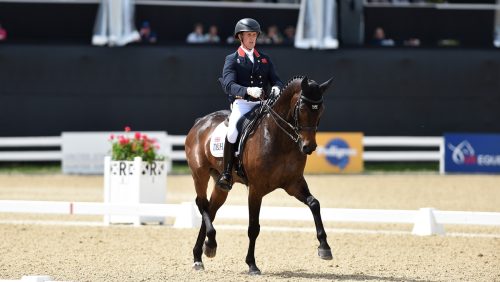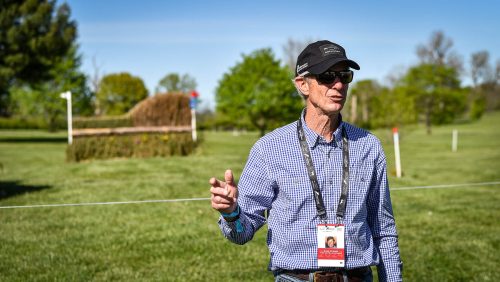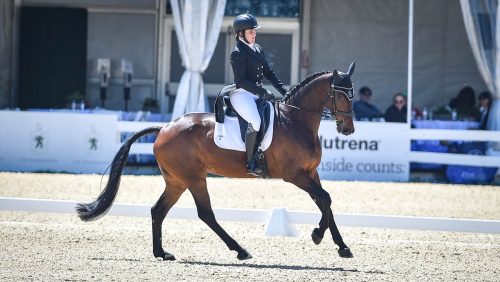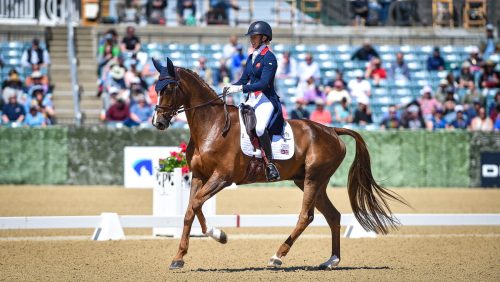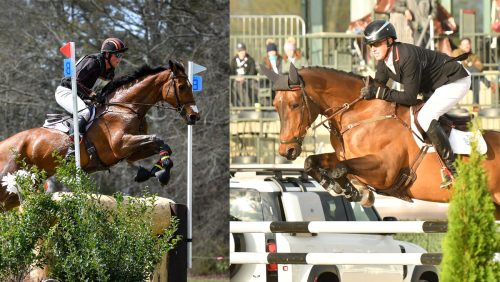On Day 2 of the Eric Smiley clinic, Cairo was eager to prove she was not one iota tired from the previous day’s efforts. She was dancing and tossing her head before we even got in the arena. Thanks to the Pacific Northwest rain making cross-country a sloppy, wet non-possibility, the clinic was all stadium fences, but Eric set the course to ask some cross-country type questions.
(You can read all about Day 1 here, in “Acceptance, Footfalls And Not Enough Coffee: Day 1 Of An Eric Smiley Clinic.”)
Cairo’s absolute lack of desire to stand still led to my volunteering to jump first each time in my group again. Crash-test dummies once again! (Duly noted, despite her antics I don’t think she took a rail either day.)
The jumps worked to get horses and riders thinking. One line of three fences had the two fences on either end near the rail set parallel and a center fence offset. It could be ridden as a line of two, or you could angle the end and center fence, or you could go down the far side of the two end fences and the other far side of the center fence.
Sounds complicated? It was, and it wasn’t—all at the same time. If you rode straight and forward, it worked great. I rode straight and not so forward the first time through—the outside fences way to the left, the middle fence way to the right, to create a straight line. The track was correct but the lack of forward made Cairo have to chip, badly. Twice.
“That was unattractive,” I said. Eric clarified that was an understatement and had me ride it again. Ridden forward, it was great. I watched the other two girls tootle right down the line and mentally reassured myself that part of “adulting” is being willing to chip fences in front of an Olympian so that younger riders do not get embarrassed.
Eric created small courses with angled fences, fences followed by going through a “chute” of poles on the ground and so on, teaching the horses to hunt the fences, ears up and think about where they were going next. He drew tracks in the sand for us to follow, pointed to places on the poles to target, and reinforced the importance of being able to ride your track and not let your horse drift.
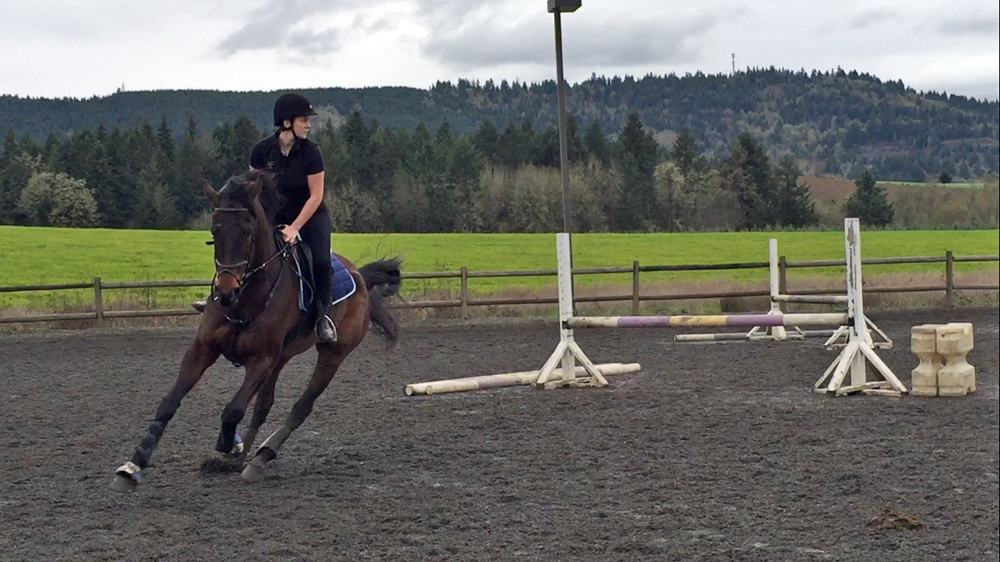
Clair Barnett on Patrick looking for the two thumbs up after riding a line focusing on straightness and throughness.
ADVERTISEMENT
He created a corner fence with a standard on one side as the top of the angle, and two standards on the other end forming the fatter bottom of the “A” shape. He asked us how many ways there were to jump the fence the way it was set: two each direction out of a right and a left turn. The ways were created by how you were able to come to the fence, out of a rollback one direction or a longer turn the other.
I was feeling pretty good about the corner fence—we did that in a Dom Schramm clinic last year—and cantered around the corner and up to it. I then promptly indulged Cairo in her right drift and proved the point Eric was making about turns and protecting against a horse’s tendency to drift a particular direction, especially over a corner.
My next go I was prepped. Cairo was in a lovely forward canter, my turn was spot on, my line to the fence was great and…two strides out she threw a gleeful buck. I was not going to be thrown by her antics in front of Eric, so I put my leg on and rode through it.
As I came back, he looked at Cairo, then looked at me. “Well, she does her job, but you wouldn’t want to be her friend would you?” he said with a laugh, pointing out the frustration of a rider setting things up correctly, only to have your horse buck. He told the story of the famous jumper and sire Galoubet A, who was phenomenally talented, but would take rails because he bucked.
I hoped Cairo was listening.
Eric explained further what he was asking the horses to do as he altered fences and tracks, and the importance of the horse being an active participant in the cross-country and its questions, admonishing us to think about what the course designer is asking, not just in the fence itself, but its approach and terrain.
Then he spread the base of the corner fence a bit wider, drew a track in the sand, and told me to ride into the open base of the corner and jump out of the right-hand pole.
For half a second, I though he was kidding—riding into it Cairo was going to think I was aiming her at a standard.
ADVERTISEMENT
He was not kidding.
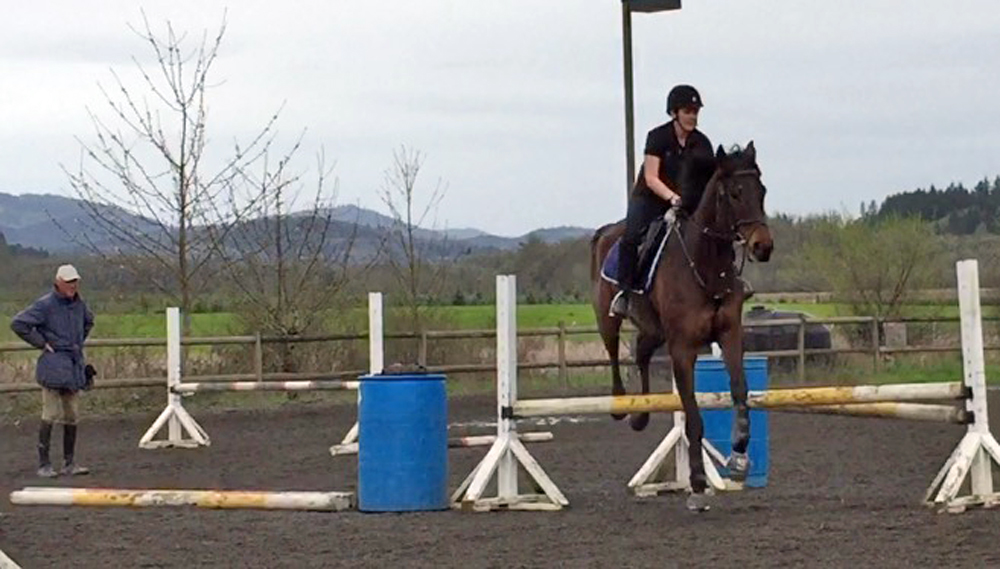
Clair Barnett on Patrick in the training/prelim group jumping the exercise of riding into the wider end of the corner fence and jumping out one of the sides. “The height of the fences were nothing but the concepts were everything,” Barnett said.
It rode great. It rode great jumping over the left-hand pole too. The exercise questioned not only your preciseness but also how much attention the horses were paying—it felt like you were basically cantering them toward a standard, but if they kept going, which my group all did, then the way out was obvious and even easy.
When you ride cross-country, the horse has to be involved, he said. If they are not involved in the process of thinking and making a decision, “I’m the one who goes to the hospital.”
Our ride is, as Eric said, a partnership, not a dictatorship. A partnership, he told us, is two individuals, each fully understanding their role, each working for a common cause. We ended on that note, feeling like we’d been challenged and succeeded and with a lot of laughs thrown in as bonus.
“Any last questions?” he asked us at the end of each session. My only one is when is he coming back to give another clinic!
Camilla Mortensen is an amateur eventer from Eugene, Ore., who started blogging for the Chronicle when she made the trek to compete in the novice level three-day at Rebecca Farm in Montana. Camilla works as a newspaper reporter by day and fits training and competing Cairo into her days.







